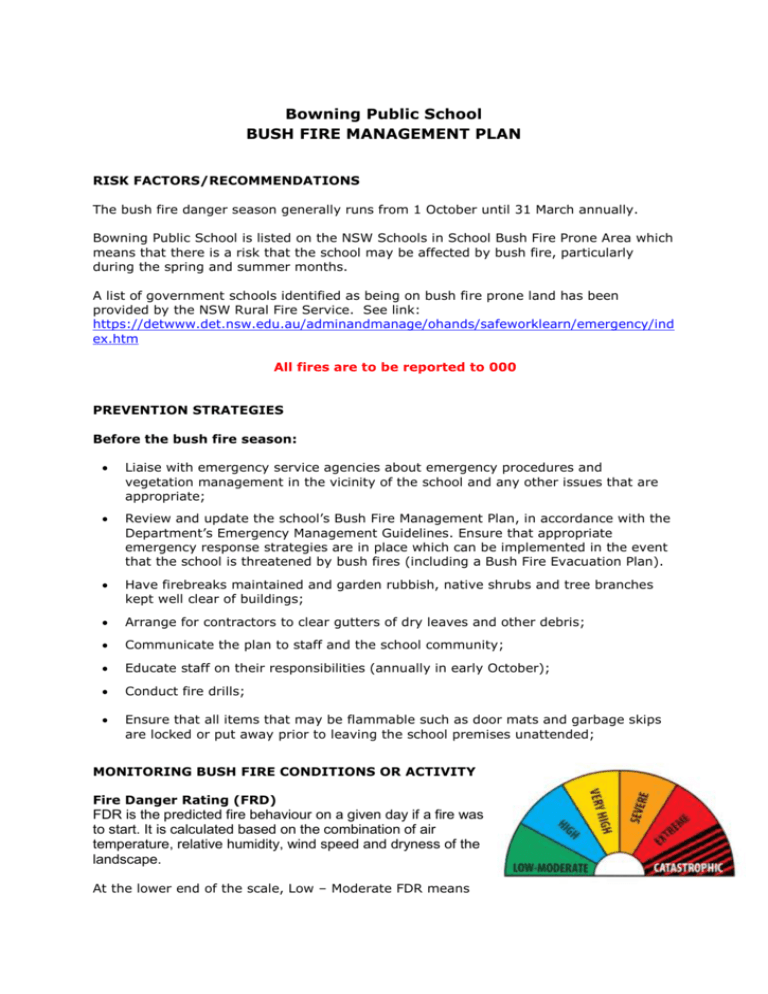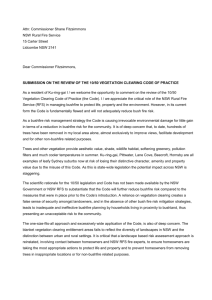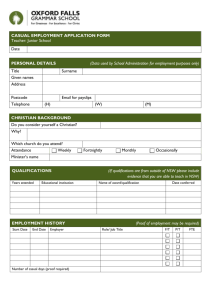BPS Bushfire Management Pla
advertisement

Bowning Public School BUSH FIRE MANAGEMENT PLAN RISK FACTORS/RECOMMENDATIONS The bush fire danger season generally runs from 1 October until 31 March annually. Bowning Public School is listed on the NSW Schools in School Bush Fire Prone Area which means that there is a risk that the school may be affected by bush fire, particularly during the spring and summer months. A list of government schools identified as being on bush fire prone land has been provided by the NSW Rural Fire Service. See link: https://detwww.det.nsw.edu.au/adminandmanage/ohands/safeworklearn/emergency/ind ex.htm All fires are to be reported to 000 PREVENTION STRATEGIES Before the bush fire season: Liaise with emergency service agencies about emergency procedures and vegetation management in the vicinity of the school and any other issues that are appropriate; Review and update the school’s Bush Fire Management Plan, in accordance with the Department’s Emergency Management Guidelines. Ensure that appropriate emergency response strategies are in place which can be implemented in the event that the school is threatened by bush fires (including a Bush Fire Evacuation Plan). Have firebreaks maintained and garden rubbish, native shrubs and tree branches kept well clear of buildings; Arrange for contractors to clear gutters of dry leaves and other debris; Communicate the plan to staff and the school community; Educate staff on their responsibilities (annually in early October); Conduct fire drills; Ensure that all items that may be flammable such as door mats and garbage skips are locked or put away prior to leaving the school premises unattended; MONITORING BUSH FIRE CONDITIONS OR ACTIVITY Fire Danger Rating (FRD) FDR is the predicted fire behaviour on a given day if a fire was to start. It is calculated based on the combination of air temperature, relative humidity, wind speed and dryness of the landscape. At the lower end of the scale, Low – Moderate FDR means that a fire will not burn, or will burn so slowly that it will be easily controlled. At the upper end of the scale, a Catastrophic FDR means that a fire will burn so fast and hot that it is likely to be uncontrollable. Catastrophic Days The State Emergency Operations Centre (SEOC) notifies the Department at approximately 4.30pm each day when there are catastrophic fire danger ratings predicted for the following day. During the Bush Fire Season: Gather up to date information on fire activity and monitor bush fire conditions by: - Listening to the local radio station and/or monitor the NSW Rural Fire Service for information about bush fire activity or fire danger ratings. - Obtaining major fire updates and preparation advice from the NSW Rural Fire Service website at www.rfs.nsw.gov.au. - Obtaining RFS Bush Fire Information Line on 1800 NSW RFS (1800 679 737) which is staffed on a 24 hour basis. - Additionally, a free IPhone application from NSW Rural Fire Service, Fires Near Me NSW. ‘Fires Near Me’ is available to download free of charge from Apple’s Application store. During the bush fire danger period, the Bureau of Meteorology issues fire danger ratings each afternoon for the following day. What the school should do when there are Active Bush Fires in the area The Principal should: Monitor ABC or local radio throughout the day and listen for updates on fire and weather conditions Regularly check the NSW Rural Fire Service website at www.rfs.nsw.gov.au Where identified, the Principal should immediately discuss their specific circumstances with local emergency services agencies, their Director Public Schools NSW and the WHS Directorate and seek appropriate advice. What the school should do where there is an imminent Bush Fire threat to the school: The school is to contact emergency services and seek appropriate advice. · The school is to inform the WHS Directorate and their Director, Public Schools NSW of the advice received so appropriate support can be provided and the information shared with all relevant stakeholders. · If the school is advised by emergency services to evacuate or if a decision is made in consultation with the Director, Public Schools NSW to temporarily cease school operations schools are to activate their Emergency Management Plan and respond accordingly. · Principals and Directors, Public Schools NSW are to notify the WHS Directorate of any school closures. The WHS Directorate will notify the State Emergency Operations Centre (SEOC) of any actions taken, including school evacuations and closures, and ensure the publication of this information on the Department's Bush Fire Safety website Schools are required to provide ongoing updates to the WHS Directorate and Director Public School NSW until normal operations have resumed. EMERGENCY RESPONSE PROCEDURES The following Emergency Response Plan was updated by Clare Pritchard in consultation with Rural Fire Service in September 2014. The school population is 43 No. of staff: 5 No. of students: 38 Special needs of persons with disabilities/illness: 1 student with diagnosed asthma and 1 anaphylaxis student Evacuation assembly area Note: Designated safe assembly areas and access routes will need to be reconsidered in consultation with emergency services at the time of the emergency. Community Assembly Point: No community assembly point in Bowning. School to evacuate to Yass Public School if safe to do so with the assistance of emergency services Transport service to support evacuation – This would be arranged with emergency services and the bus company State onsite location (stay and defend) – where safe evacuation is advised or not possible: as per consultation with Rural Fire Service (RFS) All staff, students and visitors to the school are to comply with instructions of the Principal/delegated office as to the location of designated site. The site nominated is the original brick classroom situated at the front of the school with no overhanging vegetation. If power is lost. loss of landline phone contact and lighting. (mobile telephone service would still be available) EVACUATION PROCEDURE The evacuation of occupants should take place only under the direction of the incident controller of the NSW Fire Brigades, NSW Rural Fire Service or NSW Police. However, if it is apparent that the lives of persons will be endangered unless they are evacuated immediately and the Principal is unable to contact the appropriate emergency services, the Principal will make immediate arrangements to evacuate to a safe place if it is safe to do so. In such cases, transport arrangements will be implemented in consultation with local police. Response: Arrange transport in consultation with local police. Where safety permits: o Downpipes are to be blocked and gutters filled with water. o Irrigation system / sprinklers to be turned on o Roofs to be hosed down o Check that taps are working and fill available containers with water o Bring hoses and tap fittings indoors Collect the following:o o o o o o o Torch; radio and spare batteries for each First Aid Kit, Health Care Plans and prescribed medication/s Bottled water and plastic cups Student roll, visitor’s book, mobile phone, emergency contact list (students and staff), pens Whistle or bell Spare workplace keys. Woollen blankets A roll call should be conducted including visitors, contractors prior to evacuating from the school and again at evacuation assembly point Evacuation to the identified assembly point Maintain awareness of the bushfire threat by regularly checking conditions NSW Rural Fire Service Stay tuned to the local radio station for information Provide information update to Director, Public Schools STAY and DEFEND PROCEDURE (where circumstances prevent safe evacuation) The Principal should consider the option of retreating from the most threatened location to a safer on-site location. Where possible this decision should be made in consultation with Emergency Services and the School Education Director. Note: Heat radiated by fire is intense (32° celsius compared to flames at 50° celsius) and can badly burn skin, even some distance from the flames. Response: Move to the safer / less threatened onsite location Air conditioning should be turned off Gas should be shut down at the metre or bottle Close all windows and doors (do not lock) Draw the blinds (if fitted) Place wet towels around windows and door edges to stop smoke and embers from entering. Cover as much exposed skin as possible, preferably with woollen and thick clothing. (synthetic clothing can melt whereas natural fibres are more fire resistant). Wrap clothing and other material, such as a woollen jumper, around the head. Saturate clothing with water if possible. Wet a cloth to place over the face. Drink water to guard against dehydration Woollen blanket to be taken to the classroom Assemble the group away from the part of the building which will be initially exposed to the fire keeping low (there is more air available to breathe near the ground). A roll call should be conducted – using student rolls and visitors book Once the fire front has passed and the threat from radiant heat has abated, all persons may move to the open area field and the Principal should check the buildings for outbreaks of fire Provide information update to Emergency Services and Director, Public Schools NSW A second roll call should be conducted in the new assembled area – using student rolls, staff sign in book and visitors book EMERGENCY CONTACTS NSW Rural Fire Service NSW Fire Brigade NSW Police Force NSW Ambulance Service Director, Public Schools NSW Work Health & Safety Directorate Marnie O’Brien Director, Work Health and Safety Safety & Security Directorate – Stan Zabkar Local Council Yass Valley State Emergency Service Bowning RFS Sam Kelly 000 000 000 000 W: 131 536 M: 0477 382 942 9707 6404 or 9707 6227 (office hours) 0402 352 949 (after hours) 0422 006 963 6226 1477 132500 RECOVERY ACTIONS Implementing the recovery strategy plan: The Principal will decide when to re-open the workplace, in consultation with local emergency services and the Director, Public Schools NSW Advise the school community of plans to recommence operations Normally, the NSW Fire Brigade will check that utilities (water, electricity and gas) are either safe to use or are disconnected before they leave the site. Do not attempt to turn on utilities yourself Implement procedures to resume workplace activities, which include providing counselling and support to those affected by the incident Where property has been damaged, liaise with the emergency services, Asset Management and Director, Public Schools NSW Review the Emergency Management Plan. ADDITIONAL INFORMATION: The Department's Incident Notification Procedures https://detwww.det.nsw.edu.au/policies/administrative/reporting/incident_reporting/implement ation_1_PD20070362_i.shtml?query=incident The Emergency Management page of the Department's Work Health and Safety website (intranet) https://detwww.det.nsw.edu.au/workhealthandsafety/emergency-management The Department's procedure for Temporarily ceasing school operations The Departments Bush Fire Safety website http://www.dec.nsw.gov.au/about-us/news-atdet/bushfire-safety NSW Rural Fire Service website: Fire Danger ratings http://www.rfs.nsw.gov.au/file_system/attachments/Attachment_FireDangerRating.pdf







